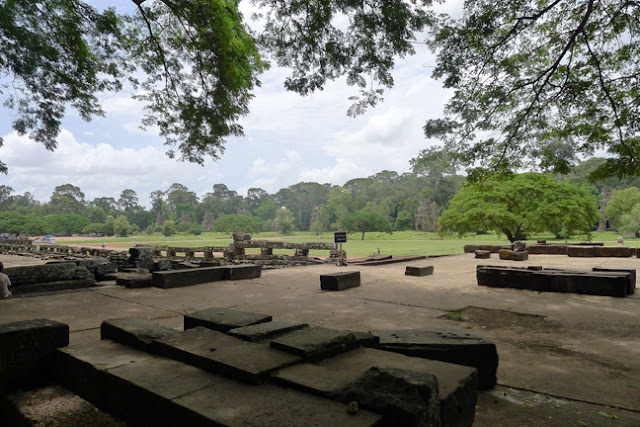OH YES, what they say is true. The Cambodian heat can be punishing, it’ll keep you company from dusk ‘til dawn. But if you ask me, it’s a better buddy than the rain, most especially if you have to be outdoors all day.
While the sparsely available shade can offer temporary cooling relief, it’s water that will prove to be your best friend. Constant hydration is the key to sustaining your energy to maximize your exploration of amazing of Siem Reap. It’s a once-you-pop-you-can’t-stop tour, quite addicting I assure you.
For Day 1, there were five temples on our list but and we never made it past number three. The magnificence of each place of worship had to be captured on film (or pixels) at every turn. Even the photos don’t do the temples justice, it’s best seen real time.
Lessons learned. After Google-ing tips on what to expect on touring Angkor—insect repellant, extra shirt, water, extra memory card and batteries for the camera, we thought we were armed. But no, we fell short on our camera artillery. We had to be prepared for the next outing.
On Day 2, we tried to be more discriminating on the shots we wanted to take but failed on this account. Once we stepped into the temples, the spirit of a trigger-happy photographer immediately possessed us. Well, we managed to capture as much as we could and take the memories home to share of more Siem Reap’s magical spots.
The Victory Gate of Angkor Thom (aka the Great City). It’s one of the five gates of the Great City.
The 23-meter towers at the city gates bear a four-faced bust at its tip which is said to represent the image of the king or the guardians of the empire’s cardinal points.
The Bayon is one of Angkor’s popular and richly decorated temples. It’s the official state temple of the King Jayavarman VII built in the late 12th century or early 13th century at the center of Angkor Thom, the Jayavarman's capital. Dedicated to the Buddha, Bayon is the only Angkorian state temple built principally as a Mahayana Buddhist shrine.
However, after this king’s reign, the Bayon underwent numerous alterations executed according to the ruler’s use of the temple.
The Terrace of the Elephants is also a part of the walled city of Angkor Thom. The 350 meter wide terrace is attached to the palace of Phimeanakas and was used by Angkor's king Jayavarman VII as the viewing deck and grand audience hall for public ceremonies.
Touring the temples of Angkor Thom was quicker than we expected. Probably we were quite excited to view the “main event” and the temple I have been looking forward to visiting for ages (only about a quarter of a century). That will be the next story.
For more travel and lifestyle stories, visit http://jeepneyjinggoy.blogspot.com/ and http://apples-and-lemons.blogspot.com/
Published in the Sun.Star Davao newspaper on August 30, 2012.
The causeway (road over the moat) fronting the towers have a row of devas (Sanskrit for deities, relating to female) on the left and asuras (power-seeking deities, considered sinful) on the right holding a naga (a deity taking form form of a great snake aka King Cobra) as if in a tug of war. This is in reference to the Angkor myth “Churning of the Sea of milk” (very interesting).
The Bayon is one of Angkor’s popular and richly decorated temples. It’s the official state temple of the King Jayavarman VII built in the late 12th century or early 13th century at the center of Angkor Thom, the Jayavarman's capital. Dedicated to the Buddha, Bayon is the only Angkorian state temple built principally as a Mahayana Buddhist shrine.
The Bayon's most distinctive features are the 216 gigantic stone faces (said to resemble the face of Jayavaeman VII’s face) carved on the towers of the temple’s upper terrace....
...and the impressive sets of bas-reliefs displaying mythological and historical scenes.
However, after this king’s reign, the Bayon underwent numerous alterations executed according to the ruler’s use of the temple.
The Terrace of the Elephants is also a part of the walled city of Angkor Thom. The 350 meter wide terrace is attached to the palace of Phimeanakas and was used by Angkor's king Jayavarman VII as the viewing deck and grand audience hall for public ceremonies.
As the name suggests, the terrace bears carvings of parading elephants on its eastern face.
Life-sized garudas and lions can also be seen on the middle section of the retaining wall.
Touring the temples of Angkor Thom was quicker than we expected. Probably we were quite excited to view the “main event” and the temple I have been looking forward to visiting for ages (only about a quarter of a century). That will be the next story.
For more travel and lifestyle stories, visit http://jeepneyjinggoy.blogspot.com/ and http://apples-and-lemons.blogspot.com/
Published in the Sun.Star Davao newspaper on August 30, 2012.

































CONVERSATION